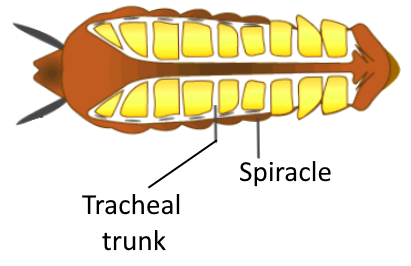
What are the organs of respiration in Arthropoda?
Answer
504.3k+ views
4 likes
Hint: It is the largest phylum which includes insects and constitutes three fourth part of the animal kingdom.
Complete answer:
Arthropoda has a tracheal respiratory system in which the exchange of gases takes place at the tracheoles by the diffusion process. In this system, the tracheal carries oxygen directly to the body cells and does not require blood to transport it.
Structure:
Trachea: The respiratory system of arthropods consists of a network of the trachea. The trachea is an air tube lined with epithelial cells.
Taenidia: The cuticular lining of the trachea is spirally thickened that appears like ridges and form taenidia. It prevents the tracheal tubes from collapsing.
Spiracles: Trachea opens externally through ten pairs of small holes named spiracles present on the lateral side of the body. The opening of spiracles is regulated by sphincters.
Tracheoles: The tracheae further subdivided into finer branches called tracheoles which are air capillaries without inner taenidia ridges. Tracheoles are lined by a protein known as trachein and they are generally filled with a fluid in which oxygen dissolves and circulates to the tissues.
Tergo-sternal muscles: These paired muscles connect the dorsal side of the body to the ventral side and are responsible for breathing. On contraction, they compress the abdominal cavity forcing air to move out. During relaxed conditions, these muscles bring the abdominal cavity back into its original shape.
Book gills: In some arthropods, book gills in the form of respiratory organs are found for respiration. This structure is made up of a series of thin plates that are highly vascular that are arranged in a manner to each other like the pages of a book.
Note:
1. Many aquatic insects like mayfly and dragonfly larvae use tracheal gills for respiration in water.
2. Tracheal gills are leaf-like extensions that present on the terminal abdominal segments.

Figure: Tracheal respiration in Arthropoda
Complete answer:
Arthropoda has a tracheal respiratory system in which the exchange of gases takes place at the tracheoles by the diffusion process. In this system, the tracheal carries oxygen directly to the body cells and does not require blood to transport it.
Structure:
Trachea: The respiratory system of arthropods consists of a network of the trachea. The trachea is an air tube lined with epithelial cells.
Taenidia: The cuticular lining of the trachea is spirally thickened that appears like ridges and form taenidia. It prevents the tracheal tubes from collapsing.
Spiracles: Trachea opens externally through ten pairs of small holes named spiracles present on the lateral side of the body. The opening of spiracles is regulated by sphincters.
Tracheoles: The tracheae further subdivided into finer branches called tracheoles which are air capillaries without inner taenidia ridges. Tracheoles are lined by a protein known as trachein and they are generally filled with a fluid in which oxygen dissolves and circulates to the tissues.
Tergo-sternal muscles: These paired muscles connect the dorsal side of the body to the ventral side and are responsible for breathing. On contraction, they compress the abdominal cavity forcing air to move out. During relaxed conditions, these muscles bring the abdominal cavity back into its original shape.
Book gills: In some arthropods, book gills in the form of respiratory organs are found for respiration. This structure is made up of a series of thin plates that are highly vascular that are arranged in a manner to each other like the pages of a book.
Note:
1. Many aquatic insects like mayfly and dragonfly larvae use tracheal gills for respiration in water.
2. Tracheal gills are leaf-like extensions that present on the terminal abdominal segments.

Figure: Tracheal respiration in Arthropoda
Latest Vedantu courses for you
Grade 11 Science PCM | CBSE | SCHOOL | English
CBSE (2025-26)
School Full course for CBSE students
₹41,848 per year
Recently Updated Pages
Express the following as a fraction and simplify a class 7 maths CBSE

The length and width of a rectangle are in ratio of class 7 maths CBSE

The ratio of the income to the expenditure of a family class 7 maths CBSE

How do you write 025 million in scientific notatio class 7 maths CBSE

How do you convert 295 meters per second to kilometers class 7 maths CBSE

Write the following in Roman numerals 25819 class 7 maths CBSE

Trending doubts
State and prove Bernoullis theorem class 11 physics CBSE

What are Quantum numbers Explain the quantum number class 11 chemistry CBSE

Write the differences between monocot plants and dicot class 11 biology CBSE

1 ton equals to A 100 kg B 1000 kg C 10 kg D 10000 class 11 physics CBSE

State the laws of reflection of light

In northern hemisphere 21st March is called as A Vernal class 11 social science CBSE




